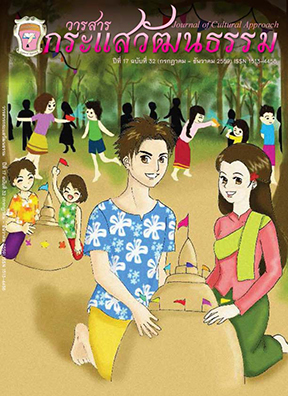The Wisdom and Inheritance of Thai Phuan Hand – Woven, Ban Mai, Nakhon Nayok
Main Article Content
Abstract
This article aims to present the wisdom and inheritance of Thai Phuan’s hand – woven, Ban Mai, Nakhon Nayok. Thai Phuan’s hand – woven wisdom is reflected through the process of weaving, and dyeing with Weft Ikat technique. The unique design involves Thai Phuan’s belief with regard to the spirit and the sanctity, propitiousness and faith in Buddhism.
The problem of passing on Thai Phuan Ban Mai has four main aspects. 1) There are few communicators and most of them are elderly. 2) The problem of cultural content and discontinuity of passing on the wisdom. 3) The problem with inheritance transfer; today, the main method is only from Thai Phuan’s hand-woven handicraft women’s group. 4) Most successors are elderly, while the younger generation is disinterested.
The way of wisdom inheritance is divided into three ways : 1) Forming the communicators and successors group both the elder and the younger. 2) Increasing the channels of inheritance through the government sector and community with systematic management and integration. 3) Inheritance of wisdom content by creating a document to prevent it from extinction along with communicators.
Article Details
Proposed Creative Commons Copyright Notices
1. Proposed Policy for Journals That Offer Open Access
Authors who publish with this journal agree to the following terms:
- Authors retain copyright and grant the journal right of first publication with the work simultaneously licensed under a Creative Commons Attribution License that allows others to share the work with an acknowledgement of the work's authorship and initial publication in this journal.
- Authors are able to enter into separate, additional contractual arrangements for the non-exclusive distribution of the journal's published version of the work (e.g., post it to an institutional repository or publish it in a book), with an acknowledgement of its initial publication in this journal.
- Authors are permitted and encouraged to post their work online (e.g., in institutional repositories or on their website) prior to and during the submission process, as it can lead to productive exchanges, as well as earlier and greater citation of published work (See The Effect of Open Access).
Proposed Policy for Journals That Offer Delayed Open Access
Authors who publish with this journal agree to the following terms:
- Authors retain copyright and grant the journal right of first publication, with the work [SPECIFY PERIOD OF TIME] after publication simultaneously licensed under a Creative Commons Attribution License that allows others to share the work with an acknowledgement of the work's authorship and initial publication in this journal.
- Authors are able to enter into separate, additional contractual arrangements for the non-exclusive distribution of the journal's published version of the work (e.g., post it to an institutional repository or publish it in a book), with an acknowledgement of its initial publication in this journal.
- Authors are permitted and encouraged to post their work online (e.g., in institutional repositories or on their website) prior to and during the submission process, as it can lead to productive exchanges, as well as earlier and greater citation of published work (See The Effect of Open Access).
References
[2] Kaewthep, Kanjana. (2006). Primary of Folk Media Knowledge “Sue Poen Ban Sue San Suk”. Bangkok : Thammasat University Press.
[3] Udon, Pipob, & Srisamut, Auttayut. (Eds.). (2013). 50 Words Unlock to ASEAN. Bangkok : The Department of ASEAN Affairs, Ministry of Foreign Affairs.
[4] The Princess Maha Chakri Sirindhorn Anthropology Centre (public organization). (2015). Wat Fung Klong Folk Museum (Thai Phuan). Retrieved February 2, 2015 from http://www.sac.or.th/databases/museumdatabase/review_inside.php?id=865
Interview
[5] Junna, Sunan. (April 16, 2015). Interviewed by Hussadin, Areewan. Patum Wongsawat Temple, Nakhon Nayok Province.
[6] Junna, Siriluk. (March 20, 2015). Interviewed by Hussadin, Areewan. Patum Wongsawat Temple, Nakhon Nayok Province.
[7] Sangmanee, Sawitree. (March 22, 2015). Interviewed by Hussadin, Areewan. Pak Phli District Office, Nakhon Nayok Province.


